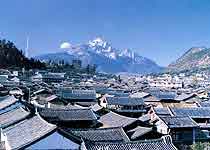The ancient city of Lijiang is also known as Dayan Town in Lijiangba. It is an intact ancient city inhabited mostly by Naxi ethnic people and covers an area of 1.5 square kilometers.
As its center there is a square. It was first built in 1126 in the late Song Dynasty and in 1253 Kublai (the first emperor of the Yuan Dynasty) was stationed here on his march into the south. Lijiang is world renowned as an ancient city built in a simple and artistic style and scientifically laid out. It was listed as a national historical and cultural city in 1986.
Lijiang City is surrounded by Lion Mountain in the west and by Elephant and Golden Row Mountains in the north. These mountains in the northwest shelter it from the cold wind. In the southeast there are fertile fields, which are dozens of kilometers long. The city is favored with plentiful sunlight, an east wind and clear spring water, which flows in three streams and reaches every family. The streets are paved with the local stone slabs, which do not get muddy in the rainy season and are free of dust in the dry season. Many stone bridges and arches in the city were built during the Ming and Qing dynasties and orderly roads and lanes extend to four directions from the central square. Residential houses are made of timber; most have a screen wall in front and some have a quadruple courtyard. Local people plant flowers in them.
The ancient traditional culture of the Naxi ethnic group is the Dongba culture, which is based on the Dongba religion. Believers practice witchcraft, are skilled in medicine and the culture is passed on through literature and art.
The Dongba language has more than 1,300 separate words, which are written in primitive pictographic characters. There are more than 1,400 types of Dongba scriptures written in these characters and they take up 20,000 volumes. The scriptures cover religion, philosophy, history, local customs, literature, art, astronomy, medicine, the calendar, geography, flora, fauna, dancing, painting and music.
Lijiang is also the home of murals painted by people from Han, Tibetan and Naxi ethnic groups who were invited to do so by herdsman Mu during the Ming Dynasty. They cover a total area of 139.22 square meters on 55 walls of Dabaoji Palace, Liuli Hall, Dabao Pavilion and Daque Palace in Laihe. The largest is 2.07 meters by 4.48 meters and contains 600 figures. Included in the UNESCO world heritage list in 1997.
Source: http://old.cnta.gov.cn |
